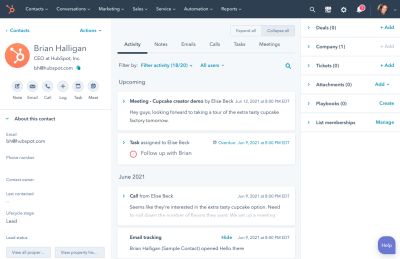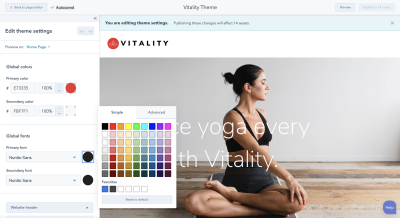Reasons To Build A CRM-Powered Website For Your Business
This article has been kindly supported by our dear friends at HubSpot who have created an ecosystem uniting software, education, and community to help businesses grow better every day. Thank you!
Most businesses today rely on simple brochure websites for their online presence. These tend to be static websites with a few pages giving core information about the business and details on products and services offered. Although these are relatively cheap and less complicated to develop than a site that offers more advanced user experiences, a business can lose out on many opportunities to better engage with their customers and close sales.
With more and more businesses coming online and creating brochure websites, shrewd organizations need to stand out from their competitors by providing fluid, memorable, and personalized user experiences on their sites. To convert potential interest in your products and services into actual sales, a business needs to foster relationships with their customers on and off their sites. By integrating CRMs with company websites, a business can substantially upgrade their customers’ experiences on their site as well as modernize their internal processes.
The acronym CRM stands for Customer Relationship Management. CRM software helps you maintain information about and cultivate relationships with your customers and leads. It does this by analyzing what each customer does on your site and maintaining the data in a contact record. It provides several ways for a business to engage with them based on that behavior. It also offers various marketing and sales tools and keeps track of the interactions company representatives have had with each customer and how it’s leading to a particular goal like closing a sale.
CRMs generally help with the organization by grouping customers into lists and sales pipelines that can be used for targeted campaigns. Usually, a CRM ships with (or can later be integrated) a CMS (Content Management System). A CMS can generate a website and allows non-technical teams to create and manage pages and content. However, CMSs by themselves are limited in tracking how visitors interact with the site.
Why Should Websites Be Integrated With A CRM Platform?
By integrating a CRM and CMS, a website can enhance visitors’ experiences through personalization, marketing automation, better customer support, and streamlined internal business processes. In this article, you will learn how CRMs improve experiences not only for customers but across internal company teams. You’ll see how a CRM can provide deeper insights into customer behavior on and off your site, and how to use this information to drive sales. Lastly, you’ll get to discover how a CRM automates and abstracts crucial but work-intense business processes and workflows.
To better illustrate what a CRM and CMS can do together, the examples in this article will reference HubSpot’s platform for both functions. HubSpot’s CRM and CMS provide virtually all the features mentioned above and as such, are a prime model. Although only the base features of a CRM and CMS will be covered here, it’s important to note that HubSpot’s platform offers an extended range of features for marketing, sales, and support.
1. Seamless Digital Experience And Boost In Marketing Efforts
When a customer visits a site, they are usually looking to make a purchase or get information. They may go through several pages on your site before they land on what they’re looking for. They’ll browse through specific products and services. They may fill a form requesting contact with a sales representative, which may take a day or two. They may not find what they’re looking for and need additional help.
“
If there is no customer support to help them handle site issues or sales representatives to guide them to complete a purchase, that is a lost opportunity. Those customers are falling through the cracks.
A CRM can enhance a user’s experience by providing help when they need it. Is something not working for them on the site? They could launch a chat window and immediately get in contact with a support agent. Do they need to consult with a sales representative who could give recommendations based on their unique needs? No problem. They just have to leave their contact information in a form. This information is collected by the CRM, a contact is created, and a sales rep is assigned. The rep is notified immediately, views all the customer’s activity, and immediately starts corresponding with them through the CRM.

With a CRM, customers who seek information can get help almost instantaneously and have the support they receive tailored to them based on their history. The CRM can also automate actions based on the customer’s activity like receiving a promotional discount code in a marketing email after they chat with a rep.
Let’s say, for example, a visitor to a motor brand site wants to purchase a car. The customer wants to find out what cars would be a good pick for them. This website was built on HubSpot’s CMS and is natively integrated with HubSpot’s CRM tooling. They see that a chat-with-a-sales-rep option is available.
When they click on it, they provide some contact information and immediately begin chatting with a rep. The rep can make recommendations based on the information the customer gives. A contact is created for the customer on the CRM. The rep can add notes to the contact. The rep can see what other pages the customer has visited. Once they are done with their chat session, the rep can send an email with more information about vehicles they may like based on the conversation they had and what the customer looked at on the site.
All of this is done through the CRM. The customer leaves the site having had an engaging experience and getting the information they needed. The rep and marketing team can then continue staying in contact with the customer through the CRM untill they make a purchase.
2. Advanced Personalization
Without a CRM, website owners tend to miss essential information about how customers use their sites on an individual basis. The information and experience they offer on their site is generic and is usually one size fits all. All customers receive the same information and treatment despite having different needs and interests in the business. If a customer’s specific need is not met by the site, they may turn to a competitor’s site that’s more engaging and useful. Losing customers and sales is bad for business.
CRMs maintain complete profiles for each customer. They contain customer preferences, history, activities, contact details, and other information. You can use it to personalize each customer’s experience on your website to better meet their needs. This can include dynamically changing the messaging and content on a website based on the needs of a specific contact, as well as a range of other things. Marketers can accommodate customer preferences in the marketing material. Salespeople can check customer activity on the site and adapt their pitches to match it. Some personalized outreach can also be automated. Based on what customers do on a site, they can go through automated conditional workflows and sequences behind the scenes, and receive helpful information about what they seek.
For example, a customer visits a magazine subscription site that uses HubSpot CMS. Because the CRM knows they work in the software industry based on a form they filled out on a previous visit, the messaging on the site is dynamically tailored to their interests. Before they continue browsing, they set their language preference to French. As part of an automatic workflow, the customer is added to a mailing list for the French version of the newsletter. Further, when they seek help through support, it is automatically offered to them in French. When marketing creates ads, the customer is served the French versions of the ads.
3. Dynamic Site Pages Are Generated Based On CRM Data
Imagine creating many similar pages for user profiles, company branches, or any other application where page layouts are the same, but the data is different. Doing this manually can be time-intensive and frustrating for both developers and marketers. But with a CMS and CRM integration, the process can be greatly simplified. Developers can create a template for the overall page structure, then data can be pulled from the CRM to dynamically generate all of the pages that are needed. Non-technical users can generate additional pages by simply adding additional records to the CRM.
For example, a real estate company has many property listings in an area. This company has a website built on HubSpot’s CMS and they create records in the CRM for each property they are selling. With this, the company can import listing data and generate individual pages for each property. They’d do this by selecting a template or building a custom one, picking what data to populate it with from the CRM, generating the pages, previewing them, and scheduling when they will go live. Using this data and the CRM, generating individual pages for each listing can be a breeze.
4. Workflows Between Developers And Marketers Are Streamlined
As touched on in the previous point, marketers rely on developers to create websites and other digital assets. If a marketer is running a campaign, they may need developers to create additional pages for it. This usually involves a lot of back and forth as they plan, build, test, and preview the site and assets before launching a campaign. A significant amount of time and effort is spent creating them. Developers sometimes have to code the individual pages and if several of them are needed, work can pile up.
Content management systems provide tools to simplify web page generation. Marketers do not need to rely on developers. If any changes need to be made to a site, marketers can do it using user-friendly drag-and-drop design tools.

This leaves developers free to handle more complicated development tasks. These systems can also offer developer tools like bug trackers and alerts, theme builders, CLI support, and more to make development easier.
A marketing department for a clothing brand is planning several campaigns at one time. They need some web pages created for each of the campaigns, but fortunately their site is built on CMS Hub. Instead of having to talk to developers, they can just log in, create the pages using drag-and-drop tools based on templates previously created by the dev team, preview the pages, then schedule them to go live. This frees up developers to work on other crucial business tasks and saves everyone time and effort.
Conclusion
Neglecting to cater your business website to your customers is not only detrimental to your sales but can also hurt your team’s productivity and operations. When customers are given a generic experience on your site, they won’t engage with it. Seeking information and help about your products and services will be frustrating.
“
Dissatisfaction festers, productivity declines and employee churn may occur. Without a CRM, repetitive and manual tasks have to be done painstakingly one at a time. This type of work takes up valuable time and effort from support, marketing, sales, and engineering teams.
Integrating a CRM with your business website has numerous benefits. For one, you can build a comprehensive profile of your customers and use that to personalize and improve their experiences on your site. You equip various departments within your company with tools to organize and automate work and improve efficiency. CRMs create great experiences for both customers and people in the company that serve them. Most importantly, it allows a business to foster and grow stronger relationships with its customers.
If you’re interested in learning more about the CMS and CRM featured in this article, you’re always welcome to visit the HubSpot website.
Further Reading
- Why Anticipatory Design Isn’t Working For Businesses
- Pricing Projects As A Freelancer Or Agency Owner
- The Importance Of Graceful Degradation In Accessible Interface Design
- How To Manage Dangerous Actions In User Interfaces

